
A spring favourite, Daffodil bulbs (Narcissus) are one of the easiest flowering bulbs to grow and readily available for sale in the USA.
They grow well in USDA Zones 3 – 8, and many varieties are available including miniature daffodils.
They are readily available for sale online from mail order nurseries. Generally a hardy bulb, easy to care for and able to withstand harsh conditions and of course those wonderful Daffodil flowers.
Blooming in springtime they provide a mass of colour if grown in the garden or container.
How to Plant Daffodil Bulbs

Daffodil bulbs are best planted in Fall and as they are cold tolerant and will over winter in the ground provided you make sure that they have good drainage.
Plant Daffodils in a well drained position where they will receive plenty of sun in late winter and spring.
Start by digging over the soil, individual holes are OK, however as gardeners normally plant daffodils in clumps, dig over the whole area to a depth of 12 inches (30 cm). Dig in some well rotted compost, some bone meal and a handful of lime.
It is always best to do this a few weeks before planting.
- Daffodils are planted with the nose (pointy end) up.
- Simply press lightly into the soil and give them some space.
- Plant at around 4 inches (10cm) apart.
- You can go closer, however you will need to dig and divide in a year or two.
- Once the bulbs are all in place, simply back fill and water well with a liquid seaweed fertiliser.

Planting Depth for different types of Daffodils
The depth at which you should plant daffodil bulbs will vary according to the variety
- The large ‘Trumpet’ bulbs should be at a depth of 6 inches (15 cm)
Miniatures at around 4 inches (10cm) - So dig out your freshly dug and turned soil to the right depth.
- And this is where the base of the bulb will sit. As a rule of thumb, 3 times the height of the bulb, so a 2 inch bulb is planted 6 inches deep.
Container Planting for Daffodils
Daffodils are great for growing in containers, a nice tight clump works well.
- So here we plant at the same depth, but closer together.
- You can put them as close as 1 inch apart, however you will need to repot them each year.
- One trick is to plant one layer a little deeper, 2 inches apart, and another layer on top sitting on the gaps. you can get a mass display, again you will need to repot each year.
- In containers you will need to fertilize every 3 weeks, use a liquid high potash fertilizer
More information
Let the foliage of daffodil bulbs die right back after flowering, this returns energy to the bulb for the next seasons flowers.
Remember to divide bulbs every 3-4 years as they tend to become overcrowded and flowering can be limited.
Many growers add Sulphate of Potash to help promote flowering, all purpose bulb fertilizers are also satisfactory.
Full Details for growing Daffodils in Containers
Lifting or Curing Daffodils for winter
The big question is, do you need to lift and cure daffodil bulbs at all. we know that in nature the species would just stay in the ground, however some gardeners do decide to lift and store the bulbs after they have finished flowering each spring or early in summer. They then replant them in fall.
So consider that this practice comes from areas with wet winters, and often wet soils, in these conditions they need to be lifted.
Here are the steps
- It is important to leave the plants in the ground until they have died back, this allows the foliage to provide the bulb itself with the nutrients required for successful growth and flowering next season.
- They may look a little untidy for a while and some gardeners like to cut off the spent flower heads. You do not need to, but it will prevent them from spending energy producing seeds.
- The next step is to lift the bulbs, best done while the foliage is still just visible (so you know where they are). Use a good garden fork and treat them gently.
- The soil is most likely dryish by this time of the year so it should fall away easily, brush off any excess and divide any clumps.
- Any damaged bulbs should be placed aside, storing damaged bulbs with good ones can cause rot and diseases. If you have accidentally ‘speared’ one or two with the fork, you can throw them away, or plant them in a container and ‘see what happens’.
- You do need to make sure the the bulbs are dry before storing, a little while in the sun will do, or perhaps spread them on a tray where they will get good air circulation.
- We use onion bags to store bulbs, they let in lots of light and air. This keeps them dry and disease free.
- You will need a cool, dry, well ventilated, dark position to hang your bag of bulbs. Some people use paper bags, not keen on these as you cant see what’s going on inside, they can also retain to much moisture.
Where to Buy
Readily available from specialist growers.

